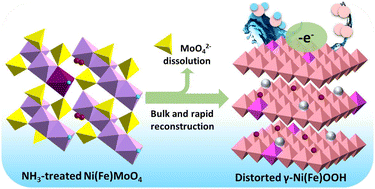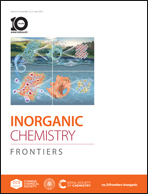Regulation of bulk reconstruction of FeNiMoO4via NH3 treatment for high performance water oxidation†
Abstract
The self-reconstruction of Ni-based electrodes and the in situ generation of oxy-hydroxides are widely investigated as crucial prerequisites for efficient oxygen evolution reaction (OER). However, the transformation is usually time-consuming and surface-limited, resulting in insufficient active sites with unsatisfactory intrinsic activity. Herein, we provide a NH3-treated Fe-doped NiMoO4 hydrate as a highly active OER pre-catalyst, with an overpotential of only 240 mV at 100 mA cm−2 and 270 mV at 300 mA cm−2. By combination of multiple quasi-situ and in situ techniques, the enhanced performance is ascribed to the lattice distortion in the pre-catalyst induced by the NH3 treatment. Firstly, the lattice defects with tensile strain and voids accelerate the selective dissolution of MoO42− and ensure the rapid and bulk reconstruction of the pre-catalyst with enriched active sites. Moreover, it could modulate the electronic structure and optimize the synergism between Ni and Fe, facilitating the dynamic evolution of Fe-doped γ-NiOOH (γ-Ni(Fe)OOH). The intimately interacted Ni–Fe dual-sites from γ-Ni(Fe)OOH and the resultant distorted structure facilitate the formation and adsorption of active oxygen species, accounting for the improved intrinsic activity for OER.



 Please wait while we load your content...
Please wait while we load your content...